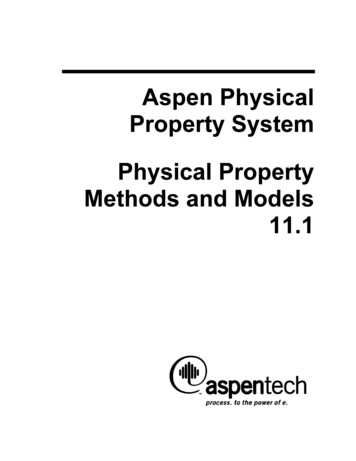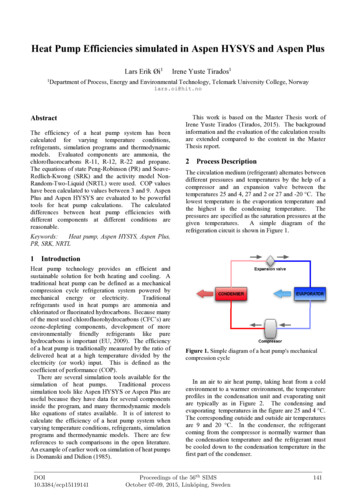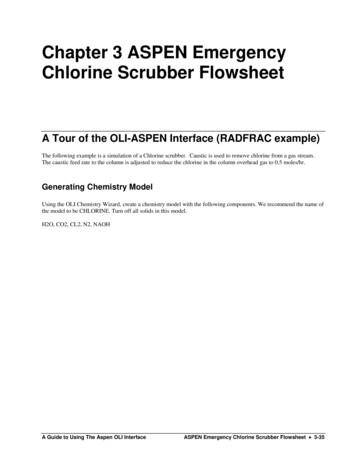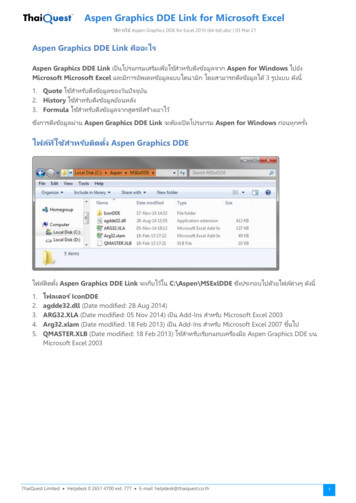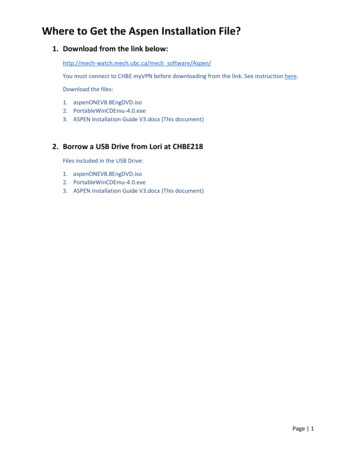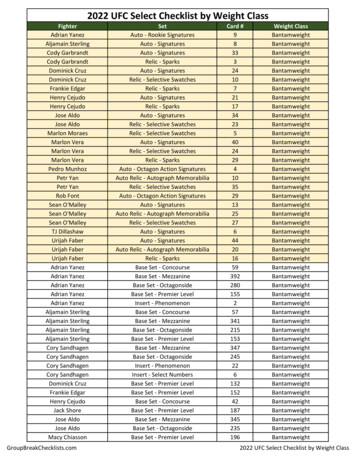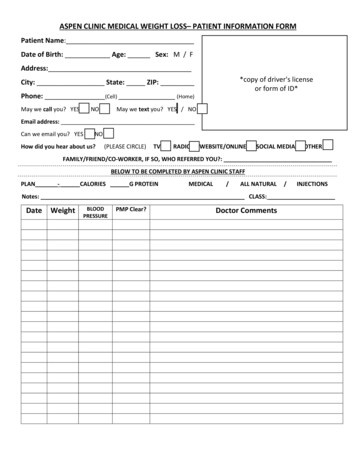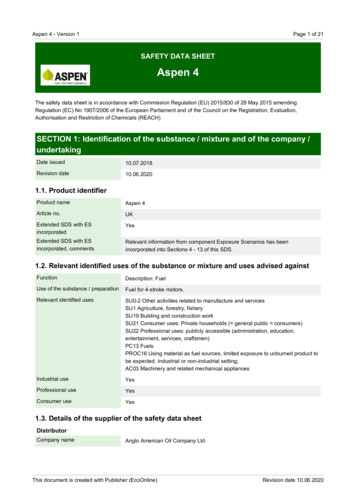
Transcription
Aspen 4 - Version 1Page 1 of 21SAFETY DATA SHEETAspen 4The safety data sheet is in accordance with Commission Regulation (EU) 2015/830 of 28 May 2015 amendingRegulation (EC) No 1907/2006 of the European Parliament and of the Council on the Registration, Evaluation,Authorisation and Restriction of Chemicals (REACH)SECTION 1: Identification of the substance / mixture and of the company /undertakingDate issued10.07.2018Revision date10.06.20201.1. Product identifierProduct nameAspen 4Article no.UKExtended SDS with ESincorporatedYesExtended SDS with ESincorporated, commentsRelevant information from component Exposure Scenarios has beenincorporated into Sections 4 - 13 of this SDS.1.2. Relevant identified uses of the substance or mixture and uses advised againstFunctionDescription: FuelUse of the substance / preparationFuel for 4-stroke motors.Relevant identified usesSU0-2 Other activities related to manufacture and servicesSU1 Agriculture, forestry, fisherySU19 Building and construction workSU21 Consumer uses: Private households ( general public consumers)SU22 Professional uses: publicly accessible (administration, education,entertainment, services, craftsmen)PC13 FuelsPROC16 Using material as fuel sources, limited exposure to unburned product tobe expected. Industrial or non-industrial setting;AC03 Machinery and related mechanical appliancesIndustrial useYesProfessional useYesConsumer useYes1.3. Details of the supplier of the safety data sheetDistributorCompany nameAnglo American Oil Company LtdThis document is created with Publisher (EcoOnline)Revision date 10.06.2020
Aspen 4 - Version 1Page 2 of 21Office address58 Holton RoadPostal addressHolton Heath Trading ParkPostcodeBH16 6LTCityPooleCountryUnited KingdomTelephone number 44 1929 551557Fax 44 1929 kProducerCompany nameLantmännen Aspen ABPostal addressIberovägen 2PostcodeSE-438 54CityHindåsCountrySwedenTelephone number 46 (0)301-23 00 00, (08:00-16.30 aspenfuels.com/1.4. Emergency telephone numberEmergency telephoneTelephone number: 112Description: SOSTelephone number: 0845 46 47 (England Wales)08454 24 24 24 (Scotland)Description: NHS - Emergency medical conditions.Telephone number: 111Description: NHS - National Poisons Information ServiceSECTION 2: Hazards identification2.1. Classification of the substance or mixtureClassification according toRegulation (EC) No 1272/2008[CLP / GHS]Flam. Liq. 1; H224Asp. Tox. 1; H304Skin Irrit. 2; H315STOT SE 3; H336Aquatic Chronic 4; H4132.2. Label elementsThis document is created with Publisher (EcoOnline)Revision date 10.06.2020
Aspen 4 - Version 1Page 3 of 21Hazard pictograms (CLP)Signal wordDangerHazard statementsH224 Extremely flammable liquid and vapour. H304 May be fatal if swallowedand enters airways. H315 Causes skin irritation. H336 May cause drowsiness ordizziness. H413 May cause long lasting harmful effects to aquatic life.Precautionary statementsP102 Keep out of reach of children.P210 Keep away from heat, hot surfaces, sparks, open flames and other ignitionsources. No smoking.P260 Do not breathe dust / fume / gas / mist / vapours / spray.P262 Do not get in eyes, on skin, or on clothing.P301 P310 IF SWALLOWED: Immediately call a POISON CENTER or doctor /physician.P331 Do NOT induce vomiting.P501 Dispose of contents / container to approved waste recipient in an opencontainer.Tactile warningsYesChild-protectionYes2.3. Other hazardsHealth effectMay cause nausea, headache, dizziness and poisoning. Narcosis in highconcentrations.In high concentrations, vapours may irritate throat and respiratory system andcause coughing.Prolonged skin contact may cause redness, irritation and dry skin.Other hazardsVapours are heavier than air and may travel along the floor and in the bottom ofcontainers. Vapours may be ignited by a spark, a hot surface or an ember.SECTION 3: Composition / information on ingredients3.2. MixturesSubstanceAlkylate (EU)Isomerat (EU)n- Butane (UK)IdentificationCAS No.: 68527-27-5,64741-64-6EC No.: 271-267-0,265-066-7REACH Reg. No.:01-2119471477-29-xxxx,01-2119485026-38-xxxxCAS No.: 64741-70-4EC No.: 265-073-5REACH Reg. No.:01-2119480399-24CAS No.: 106-97-8EC No.: 203-448-7This document is created with Publisher (EcoOnline)ClassificationFlam. Liq. 1; H224Asp. tox. 1; H304Skin Irrit. 2; H315STOT SE 3; H336Aquatic Chronic 2; H411Contents80 - 95 %Notes1Flam. Liq. 1; H224Asp. tox. 1; H304Aquatic Chronic 2; H411Skin Irrit. 2; H315STOT SE 3; H336Flam. Gas 1; H220Press. Gas; H2805 - 15 %10-4%2Revision date 10.06.2020
Aspen 4 - Version 1Isopentane (UK)12Page 4 of 21REACH Reg. No.:01-211947469 1-31CAS No.: 78-78-4EC No.: 201-142-8REACH Reg. No.:01-2119475602-38-0004Flam. Liq. 1; H224Asp. tox. 1; H304STOT SE 1; H336Aquatic Chronic 2; H411 2.5 %1,2Substance classified with a health or environmental hazardSubstance with a workplace exposure limitRemarks, substanceBenzene 0,1% n-Hexane 3%.Ingredients' environmental classification is not supported by tests on the mixture.SECTION 4: First aid measures4.1. Description of first aid measuresGeneralFire and explosion: Leave the zone of danger immediately and evacuateunnecessary personnel. Bring injured persons out of the zone of dangerimmediately. Beware of danger of shock in seemingly not-injured persons. Ifbreathing is difficult, remove victim to fresh air and keep at rest in a positioncomfortable for breathing.InhalationFresh air and rest. Get medical attention if any discomfort continues.Skin contactRemove contaminated clothing immediately and wash skin with soap and water.Eye contactImmediately rinse with water for several minutes. Make sure to remove anycontact lenses from the eyes before rinsing.IngestionDO NOT induce vomiting. Get medical attention immediately.Do not induce vomiting. If vomiting occurs, the head should be kept low so thatstomach vomit doesn't enter the lungs. Droplets of the product aspirated into thelungs through ingestion or vomiting may cause a serious chemical pneumonia.A doctor should decide if gastric lavage is needed.4.2. Most important symptoms and effects, both acute and delayedAcute symptoms and effectsActs as a defatting agent on skin. May cause cracking of skin, and eczema.Risk of chemical pneumonia after aspiration. Vapour may irritate respiratorysystem or lungs.Delayed symptoms and effectsWarning! This product is harmful to health. The product may be aspirated andcause chemical pneumonia that can be fatal.4.3. Indication of any immediate medical attention and special treatment neededMedical treatmentTreat Symptomatically.Medical monitoring for delayedeffectsCentral nervous system depression including narcotic effects such asdrowsiness, narcosis, reduced alertness, loss of reflexes, lack of coordinationand vertigo.Other informationDO NOT INDUCE VOMITING! Intrusion into the lungs after ingestion or vomitingmay cause chemical pneumonitis.SECTION 5: Firefighting measuresThis document is created with Publisher (EcoOnline)Revision date 10.06.2020
Aspen 4 - Version 1Page 5 of 215.1. Extinguishing mediaSuitable extinguishing mediaExtinguish with foam, carbon dioxide, dry powder or water fog.Improper extinguishing mediaDo not use water jet as an extinguisher, as this will spread the fire.5.2. Special hazards arising from the substance or mixtureFire and explosion hazardsHighly flammable liquid and vapour. Eliminate all ignition sources if safe to do so.Severe explosion hazard when vapours are exposed to flames.5.3. Advice for firefightersPersonal protective equipmentIn case of inadequate ventilation wear respiratory protection. Use personalprotective equipment as required.Fire fighting proceduresContainers close to fire should be removed immediately or cooled with water.Avoid water in straight hose stream; will scatter and spread fire. Be aware of riskof fire re-starting, and risk of explosion.Other informationVapours are heavier than air and may travel along the floor and in the bottom ofcontainers. Vapours may be ignited by a spark, a hot surface or an ember.SECTION 6: Accidental release measures6.1. Personal precautions, protective equipment and emergency proceduresPersonal protection measuresDo not smoke or use open fire, or other sources of ignition. Ventilate well. In caseof inadequate ventilation use suitable respirator. Take precautionary measuresagainst static discharges.6.2. Environmental precautionsEnvironmental precautionarymeasuresAvoid discharge into drains, water courses or onto the ground. Contain spillageswith sand, earth or any suitable adsorbent material. Contact local authorities incase of spillage to drain/aquatic environment.6.3. Methods and material for containment and cleaning upClean upAbsorb in vermiculite, dry sand or earth and place into containers. Cover largespillages with foam.Other informationRemove sources of ignition. Beware of the explosion danger.6.4. Reference to other sectionsOther instructionsFor waste disposal, see section 13. For personal protection, see section 8.SECTION 7: Handling and storage7.1. Precautions for safe handlingHandlingFlammable/combustible - Keep away from oxidisers, heat and flames. Takeprecautionary measures against static discharges.Protective safety measuresThis document is created with Publisher (EcoOnline)Revision date 10.06.2020
Aspen 4 - Version 1Page 6 of 21Safety measures to prevent fireStore in a well-ventilated place. Keep cool.Preventitive measures to preventaerosol and dust generationWell-ventilated area.Preventititve measures to protectthe environmentPrevent entry into drains.7.2. Conditions for safe storage, including any incompatibilitiesStorageStore in tightly closed original container in a well-ventilated place. Store attemperature below 50 C. Flammable liquid storage.Conditions to avoidKeep away from heat, sparks and open flame.Conditions for safe storageTechnical measures and storageconditionsProtect electric equipment against sparking in case of risk of explosion.Advice on storage compatabilityKeep flammable liquids away from flammable gas and highly flammable goods.Flammability class: 1Additional information on storageconditionsLarge amounts and storages should be stored in accordance with nationalregulation on storage of flammable liquids.7.3. Specific end use(s)Specific use(s)The identified uses for this product are detailed in Section 1.2.SECTION 8: Exposure controls / personal protection8.1. Control parametersSubstancen- Butane (UK)IdentificationCAS No.: 106-97-8Isopentane (UK)CAS No.: 78-78-4Petroleum (UK)n-Hexane (UK)CAS No.: 110-54-3This document is created with Publisher (EcoOnline)Exposure limitsTWA YearCountry of origin: GBLimit value type: WELLimit value (8 h) : 600 ppmLimit value (8 h) : 1450 mg/m³Limit value (short term)Value: 750 ppmLimit value (short term)Value: 1810 mg/m³Country of origin: EULimit value (8 h) : 1000 ppmLimit value (8 h) : 3000 mg/m³Country of origin: UKLimit value (8 h) : 600 ppmLimit value (8 h) : 1800 mg/m³Country of origin: UKLimit value (8 h) : 20 ppmLimit value (8 h) : 72 mg/m³Source: EH40/2005,Revision date 10.06.2020
Aspen 4 - Version 1Page 7 of 21Benzene (UK)CAS No.: 71-43-2Toluene (UK)CAS No.: 108-88-3Other Information about thresholdlimit valuesWorkplace exposure limits,Third edition 2018Country of origin: UKLimit value (8 h) : 1 ppmLimit value (8 h) : 3,25 mg/m³Exposure limit letterLetter code: Carc, SkSource: EH40/2005,Workplace exposure limits,Third edition 2018Country of origin: UKLimit value (8 h) : 50 ppmLimit value (8 h) : 191 mg/m³Limit value (short term)Value: 100 ppmLimit value (short term)Value: 384 mg/m³Limit value (short term)Appraisal period: 15 minExposure limit letterLetter code: SkSource: EH40/2005,Workplace exposure limits,Third edition 2018Petroleum Work Exposure Limits applies to both Alkylate and Isomerate.DNEL / PNECSubstanceAlkylate (EU)DNELGroup: ProfessionalRoute of exposure: Acute inhalation (systemic)Value: 1300 mg/m³Reference: 15 minComments: 68527-27-5Group: ProfessionalRoute of exposure: Acute inhalation (local)Value: 1100 mg/m³Reference: 15 minComments: 68527-27-5Group: ProfessionalRoute of exposure: Long-term inhalation (local)Value: 840 mg/m³Reference: 8 hComments: 68527-27-5Group: ConsumerRoute of exposure: Acute inhalation (systemic)Value: 1200 mg/m³Reference: 15 minThis document is created with Publisher (EcoOnline)Revision date 10.06.2020
Aspen 4 - Version 1Page 8 of 21Comments: 68527-27-5Group: ConsumerRoute of exposure: Acute inhalation (local)Value: 640 mg/m³Reference: 15 minComments: 68527-27-5Group: ConsumerRoute of exposure: Long-term inhalation (local)Value: 180 mg/m³Reference: 24 hComments: 68527-27-5SubstanceIsomerat (EU)DNELGroup: ProfessionalRoute of exposure: Acute inhalation (systemic)Value: 1300 mg/m³Reference: 15 minGroup: ProfessionalRoute of exposure: Acute inhalation (local)Value: 1100 mg/m³Reference: 15 minGroup: ProfessionalRoute of exposure: Long-term inhalation (local)Value: 840 mg/m³Reference: 8 hGroup: ConsumerRoute of exposure: Acute inhalation (systemic)Value: 1200 mg/m³Reference: 15 minGroup: ConsumerRoute of exposure: Acute inhalation (local)Value: 640 mg/m³Reference: 15 minGroup: ConsumerRoute of exposure: Long-term inhalation (systemic)Value: 180 mg/m³Reference: (24 h)SubstanceIsopentane (UK)DNELGroup: ProfessionalRoute of exposure: Long-term dermal (systemic)Value: 432 mg/kg bw/dayGroup: ConsumerRoute of exposure: Long-term dermal (systemic)Value: 214 mg/kg bw/dayGroup: ProfessionalThis document is created with Publisher (EcoOnline)Revision date 10.06.2020
Aspen 4 - Version 1Page 9 of 21Route of exposure: Long-term inhalation (systemic)Value: 3000 mg/m³Group: ConsumerRoute of exposure: Long-term inhalation (systemic)Value: 643 mg/m³Route of exposure: Long-term oral (systemic)Value: 214 mg/kg bw/dayValue: 1296 mg/kg bw/dayComments: NOAELValue: 1070 mg/kg bw/dayComments: NOAELValue: 9000 mg/m³Comments: NOAECValue: 3215 mg/m³Comments: NOAECValue: 1070 mg/kg bw/dayComments: NOAEL DNELs are derived from the Indicative OccupationalExposure Limit (IOEL) for Pentane, Isopentane, and NeopentanePNECRoute of exposure: FreshwaterReference: 2.6 x 10 (-6) mg/lRoute of exposure: SaltwaterValue: 0.0000055 µg/lReference: 5.5 x 10 (-9) mg/lRoute of exposure: Freshwater sedimentsValue: 0.0036 µg/lReference: 3.6 x 10 (-6) mg/kgRoute of exposure: Saltwater sedimentsReference: 6.7 x 10 (-9) mg/lRoute of exposure: SoilReference: 1.6 x 10 (-8) mg/kgComments: NaturalRoute of exposure: SoilReference: 3.5 x 10 (-8) mg/kgComments: Agricultural.Route of exposure: WaterReference: 1.3 x 10 (-6) mg/lRoute of exposure: AirReference: 9.2 x 10 (-5) mg/m3Comments: PNEC for isopentane has been derived using the HC5 statisticalextrapolation method and the target lipid model.8.2. Exposure controlsThis document is created with Publisher (EcoOnline)Revision date 10.06.2020
Aspen 4 - Version 1Page 10 of 21Safety signsPrecautionary measures to prevent exposureAppropriate engineering controlsDo not handle near food and drink.Provide access to washing facilities incl. soap, skin cleanser and fatty cream.Observe occupational exposure limits and minimise the risk of inhalation ofvapours and mist.Technical measures to preventexposureProvide adequate general and local exhaust ventilation.Eye / face protectionAdditional eye protectionmeasuresContact lenses should not be worn when working with this chemical!Eye protection, commentsWear approved chemical safety goggles where eye exposure is reasonablyprobable.Hand protectionSuitable materialsNitrile.Required properties for handprotectionSkyddsklass: 6 EN 374. EN 420Breakthrough timeValue: 8 hour(s)Thickness of glove materialValue: 0.4 mmHand protection, commentsProtective gloves should be used if there is a risk of direct contact or splash. Beaware that the liquid may penetrate the gloves. Frequent change is advisable.Skin protectionSuitable protective clothingWear appropriate clothing to prevent reasonably probable skin contact.Additional skin protectionmeasuresWash promptly with soap & water if skin becomes contaminated.Skin protection remarkRemove contaminated clothing and wash the skin thoroughly with soap andwater after work. Please note that contaminated clothing may present a risk offire and / or explosion. Personal protection must be kept separate from otherclothes.Respiratory protectionRespiratory protection necessaryatUnder normal conditions of use respiration protection should not be required.Tasks needing respiratoryprotectionRespiratory protection must be used if air contamination exceeds acceptablelevel.Recommended type of equipmentUse respiratory equipment with gas filter, type AX.Additional respiratory protectionmeasuresAll handling to take place in well-ventilated area.This document is created with Publisher (EcoOnline)Revision date 10.06.2020
Aspen 4 - Version 1Respiratory protection, commentsPage 11 of 21Filter with half mask. Filter equipment may be used for a maximum of 2 hours pertime.Hygiene / environmentalSpecific hygiene measuresPromptly remove non-impervious clothing that becomes wet.DO NOT SMOKE IN WORK AREA!Appropriate environmental exposure controlEnvironmental exposure controlsShould be prevented from entering drains. Inform Authorities if large amounts areinvolved.Environmental exposure controls,commentsVOC.Exposure controlsSafety measures for consumeruse of the chemicalThis product is not to be used under conditions of poor ventilation.Remove contaminated clothing and wash the skin thoroughly with soap andwater after work.Good personal hygiene is necessary. Wash hands and contaminated areas withwater and soap before leaving the work site.Do not store tobacco, food or beverage in work rooms or areas where theproduct is used.SECTION 9: Physical and chemical properties9.1. Information on basic physical and chemical propertiesPhysical stateColoured liquid.ColourTan.OdourKerosene.pHStatus: In delivery stateComments: Not relevant.Status: In aqueous solutionComments: Not relevant.Melting point / melting rangeComments: Not relevant.Boiling point / boiling rangeValue: 30 -205 CMethod: EN ISO 3405Value: 75 CMethod: NFPA 30 (USA)Flash pointValue: 0 CEvaporation rateValue: 1000Method: BuAc 100Lower explosion limit with unit ofmeasurementValue: 1 vol%Upper explosion limit with units ofmeasurementValue: 8 vol%This document is created with Publisher (EcoOnline)Revision date 10.06.2020
Aspen 4 - Version 1Page 12 of 21Vapour pressureValue: 55 - 65 kPaMethod: EN 13016-1Temperature: 37.8 CVapour densityValue: 1Reference gas: Air.Relative densityValue: 690 - 720 kg/m3Method: EN ISO 12185SolubilityComments: Very soluble in: Hydrocarbons.Comments: Solubility: 1 - 6 mg/lPartition coefficient: n-octanol/waterValue: 4,3 - 4,8Comments: Calculated value for mixture.Spontaneous combustabilityValue: 300 CViscosityValue: 1 mm2/sTemperature: 40 C9.2. Other informationPhysical hazardsFlammable liquidsClassification: H224 Extremely flammable liquid and vapour.ConductivityValue: 0.0002 µS/mMethod: EN 15938Comments: (200 pS/m)Temperature: 20 CGas groupComments: IIA.SECTION 10: Stability and reactivity10.1. ReactivityReactivityThere are no known reactivity hazards associated with this product.10.2. Chemical stabilityStabilityStable under normal temperature conditions and recommended use.10.3. Possibility of hazardous reactionsPossibility of hazardous reactionsContains a volatile component. Vapours may form explosive mixtures with air.10.4. Conditions to avoidConditions to avoidAvoid heat, flames and other sources of ignition.10.5. Incompatible materialsMaterials to avoidAvoid contact with oxidising agents.10.6. Hazardous decomposition productsThis document is created with Publisher (EcoOnline)Revision date 10.06.2020
Aspen 4 - Version 1Hazardous decompositionproductsPage 13 of 21None under normal conditions.SECTION 11: Toxicological information11.1. Information on toxicological effectsSubstanceAlkylate (EU)Acute toxicityType of toxicity: AcuteEffect tested: LD50Route of exposure: OralMethod: OECD 401Value: 5000 mg/kgAnimal test species: RatComments: 68527-27-5Type of toxicity: AcuteEffect tested: LC50Route of exposure: Inhalation.Method: OECD 403Value: 5610 mg/m³Animal test species: RatComments: 68527-27-5Effect tested: LD50Route of exposure: DermalMethod: OECD 402Value: 2000 mg/kg bwAnimal test species: RabbitComments: 68527-27-5Effect tested: LD50Route of exposure: OralValue: 5000 mg/kgAnimal test species: RatComments: 64741-64-6Effect tested: LD50Route of exposure: DermalValue: 2000 mg/kgAnimal test species: RabbitComments: 64741-64-6Effect tested: LC50Route of exposure: Inhalation.Value: 5.2 mg/lAnimal test species: RatTest reference: 4 hrComments: 64741-64-6SubstanceIsomerat (EU)Acute toxicityEffect tested: LD50Route of exposure: OralMethod: OECD 401Value: 5000 mg/kgThis document is created with Publisher (EcoOnline)Revision date 10.06.2020
Aspen 4 - Version 1Page 14 of 21Animal test species: RatEffect tested: LD50Route of exposure: DermalMethod: OECD 402Value: 5000 mg/kgAnimal test species: RabbitEffect tested: LC50Route of exposure: Inhalation.Method: OECD TG 403Value: 5610 mg/m³Animal test species: RatSubstancen- Butane (UK)Acute toxicityEffect tested: LC50Route of exposure: Inhalation.Method: Calculated.Value: 20 mg/lSubstanceIsopentane (UK)Acute toxicityType of toxicity: AcuteRoute of exposure: OralMethod: Read-across: n-pentane.Value: 2000 mg/kgAnimal test species: RatType of toxicity: AcuteRoute of exposure: OralMethod: Read-across: cyclopentane.Value: 5000 mg/kgAnimal test species: RatType of toxicity: AcuteRoute of exposure: Inhalation.Method: Read-across: cyclopentane.Value: 25.3 mg/lAnimal test species: RatType of toxicity: SubchronicEffect tested: NOECRoute of exposure: Inhalation.Value: 2220 ppmAnimal test species: RatComments: Organ.Type of toxicity: ChronicEffect tested: NOECRoute of exposure: Inhalation.Value: 6646 ppmAnimal test species: RatComments: Neurologisk.Other information regarding health hazardsThis document is created with Publisher (EcoOnline)Revision date 10.06.2020
Aspen 4 - Version 1Page 15 of 21SubstanceAlkylate (EU)Skin corrosion / irritation test resultToxicity type: Skin corrosionMethod: OECD 404Evaluation result: Prolonged contact may cause redness, irritation and cracking.64741-64-6Comments: Irritating to respiratory system. The product causes irritation ofmucous membranes and may cause abdominal discomfort if swallowed.68527-27-5Skin corrosion / irritation, otherinformationIrritating to skin. Gas or vapour may irritate respiratory system. Liquid irritatesmucous membranes and may cause abdominal pain if swallowed.InhalationIn high concentrations, vapours are narcotic and may cause headache, fatigue,dizziness and nausea.Skin contactProduct has a defatting effect on skin. Prolonged or repeated contact leads todrying of skin.IngestionHarmful: may cause lung damage if swallowed.Germ cell mutagenicityComments: Contains 0.1% benzene. The product does not need to be classifiedas Carcinogen, Mutagen or Reproductions toxic (CMR) due to low concentrationsof components suspected or known to be CMR.CarcinogenicityComments: Contains 0.1% benzene and therefore is not classified as acarcinogen.Reproductive toxicityComments: Contains 0.1% benzene. The product does not need to be classifiedas Carcinogen, Mutagen or Reproductions toxic (CMR) due to low concentrationsof components suspected or known to be CMR.SubstanceAlkylate (EU)Specific target organ toxicity single exposure, test resultsToxicity type: AcuteSpecific effect: Central nervous system depression including narcotic effectssuch as drowsiness, narcosis, reduced alertness, loss of reflexes, lack ofcoordination and vertigo.Toxicity type: ChronicEvaluation result: Based on available data the classification criteria are not met.Test reference: OECD 410 OECD 412 OECD 453 EPA OPPTS 870.3465Assessment of specific targetorgan toxicity - single exposure,classificationCentral nervous system depression including narcotic effects such asdrowsiness, narcosis, reduced alertness, loss of reflexes, lack of coordinationand vertigo.SubstanceAlkylate (EU)Aspiration hazard, test resultsComments: Pneumonia may be the result if vomited material containing solventsreaches the lungs. DO NOT induce vomiting if swallowed chemical is dissolved inpetroleum-based material. Danger of aspiration and development of chemicalpneumonia.Ingestion of even small quantities may be fatal.Aspiration hazard due tohydrocarbon content, commentsIngestion may cause severe irritation of the mouth, the oesophagus and thegastrointestinal tract. H304 May be fatal if swallowed and enters airways.Aspiration hazard, commentsRisk of chemical pneumonia after aspiration.Symptoms of exposureThis document is created with Publisher (EcoOnline)Revision date 10.06.2020
Aspen 4 - Version 1Page 16 of 21In case of ingestionIngestion may cause severe irritation of the mouth, the oesophagus and thegastrointestinal tract.Pneumonia may be the result if vomited material containing solvents reaches thelungs.In case of skin contactDefatting, drying and cracking of skin.In case of inhalationInhalation of oil mist or vapours formed during heating of the product will irritatethe respiratory system and provoke coughing.Other informationIn case of overexposure, organic solvents may depress the central nervoussystem causing dizziness and intoxication, and at very high concentrationsunconsciousness and death.SECTION 12: Ecological information12.1. ToxicityAquatic toxicity, fishValue: 100 mg/lTest duration: 96hSpecies: Danio rerioMethod: OECD TG no. 203 (2004)Test reference: Test report 046/13.Comments: LL50.Results for the mixture.SubstanceIsopentane (UK)Aquatic toxicity, fishToxicity type: AcuteValue: 34.05 mg/lEffect dose concentration : LL50Exposure time: 96 hour(s)Method: QSARToxicity type: AcuteValue: 4.26 mg/lEffect dose concentration : LC50Exposure time: 96 hour(s)Method: Study.Toxicity type: ChronicValue: 7.618 mg/lExposure time: 28 day(s)Method: NOELR QSAR.Aquatic toxicity, algaeValue: 100 mg/lTest duration: 72hSpecies: Raphidoceles subcapitataMethod: OECD TG no. 202Test reference: Test report 182/06.Comments: EL50. Results for mixture.SubstanceIsopentane (UK)Aquatic toxicity, algaeValue: 5.2 mg/lEffect dose concentration : EC50Exposure time: 96 hour(s)Species: green algaeMethod: QSAR.This document is created with Publisher (EcoOnline)Revision date 10.06.2020
Aspen 4 - Version 1Page 17 of 21Value: 10.7 mg/lEffect dose concentration : EC50Exposure time: 72 hour(s)Species: Scenedesmus capricornutumMethod: (Growth rate.) Read across.Value: 7.51 mg/lEffect dose concentration : EC50Exposure time: 72 hour(s)Species: Scenedesmus capricornutumMethod: (Biomass.) Read across.Value: 1.26 mg/lEffect dose concentration : EC50Exposure time: 72 hour(s)Species: Scenedesmus capricornutumMethod: (Biomass.) Read across.Value: 7.51 mg/lEffect dose concentration : NOECExposure time: 72 hour(s)Species: Scenedesmus capricornutumMethod: (Growth rate.) Read across.Comments: Based on key study.The toxicity of 2-methylbutane to algae has been read across within the categoryfrom n-pentane.:EC 50 growth rate 10.7 mg/l, and NOEC growth rate 2.04 mg/L.Aquatic toxicity, crustaceanValue: 1000 mg/lTest duration: 48hSpecies: Daphnia MagnaMethod: OECD Tg no. 201Test reference: Test report 31/04.Comments: EL50. Data applies to formulation mixture.SubstanceIsopentane (UK)Aquatic toxicity, crustaceanToxicity type: AcuteValue: 2.3 mg/lEffect dose concentration : EC50Exposure time: 48 hour(s)Method: Study.Toxicity type: AcuteValue: 4.2 mg/lEffect dose concentration : EC50Exposure time: 48 hour(s)Method: Study.Toxicity type: AcuteValue: 59.44 mg/lEffect dose concentration : EL50Exposure time: 48 hour(s)Method: QSAR.Toxicity type: ChronicThis document is created with Publisher (EcoOnline)Revision date 10.06.2020
Aspen 4 - Version 1Page 18 of 21Value: 13.29 mg/lExposure time: 21 day(s)Method: NOELR QSAR.SubstanceAlkylate (EU)Toxicity to bacteriaValue: 15.41 mg/lEffect dose concentration : LL50Exposure time: 72 hour(s)Species: Tetrahymena pyriformisMethod: QSAR PetrotoxComments: 64741-64-612.2. Persistence and degradabilityPersistence and degradabilitydescription/evaluationVolatile substances are degraded in the atmosphere within a few days. Theproduct is degraded completely by photochemical oxidation. The product has notproven to be degradable under anaerobic conditions.Chemical oxygen demand (COD)Comments: Not known.Biological oxygen demand (BOD)Comments: Not known.12.3. Bioaccumulative potentialBioconcentration factor (BCF)Value: 4,3 - 4,8Method: Log KowComments: Calculated value for mixture.Bioaccumulation, evaluationBioaccumulation is unlikely to be significant because of the low water solubility ofthis product.12.4. Mobility in soilMobilityThe product contains volatile organic compounds (VOC) which will evaporateeasily from all surfaces. The product is insoluble in water and will spread on thewater surface.12.5. Results of PBT and vPvB assessmentResults of PBT and vPvBassessmentThis product does not contain any PBT or vPvB substances.12.6. Other adverse effectsSECTION 13: Disposal considerations13.1. Waste treatment methodsAppropriate methods of disposalfor the chemicalMake sure containers are empty before discarding (explosion risk). Vent toatmosphere. Disposal to licensed waste disposal site in accordance with localWaste Disposal Authority.Appropriate methods of disposalfor the contaminated packagingIf container is completely emptied, well-vented and free from product residuesthat can pose hazardous properties - the following EWC codes can be useddepending on package material:This document is created with Publisher (EcoOnline)Revision date 10.06.2020
Aspen 4 - Version 1Page 19 of 2115 01 02 plastic packaging, 15 01 04 me
Aspen 4 10.07.2018 10.06.2020 Aspen 4 UK Yes Relevant information from component Exposure Scenarios has been incorporated into Sections 4 - 13 of this SDS. Description: Fuel Fuel for 4-stroke motors. SU0-2 Other activities related to manufacture and services SU1 Agriculture, forestry, fishery SU19 Building and construction work
